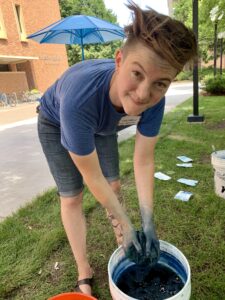 Inspired by the Linnaeus Arboretum and other nature spots that surround Gustavus Adolphus College, a dye garden by Colleen Stockmann brings centuries-old art techniques int the 21st century.
Inspired by the Linnaeus Arboretum and other nature spots that surround Gustavus Adolphus College, a dye garden by Colleen Stockmann brings centuries-old art techniques int the 21st century.
The dye garden involves growing plants such as marigold, fennel, and blackberry that release their color if simmered in water. This process of obtaining dyes was highly used before the invention of synthetic dyes in the 1850s.
“Experiential learning is part of my artistic and scholarly practices,” said Stockmann. ”As I researched indigo production during the eighteenth century, for example, I found a lot of questions about the process and a kind of magical explanation – so I wanted to know more about that magic firsthand.”
To supplement her research with hands-on experience, Stockmann learned how to indigo dye from local artists, then began experimenting with colleagues. In time, she hopes that art courses will spend time with the dye garden, possibly growing other materials such as grasses to make paper or baskets.
“Given the proximity of the art building to the arboretum and my research, it seemed like a natural fit to make more connections between the plant world and the paint world.”

Leave a Reply
You must be logged in to post a comment.